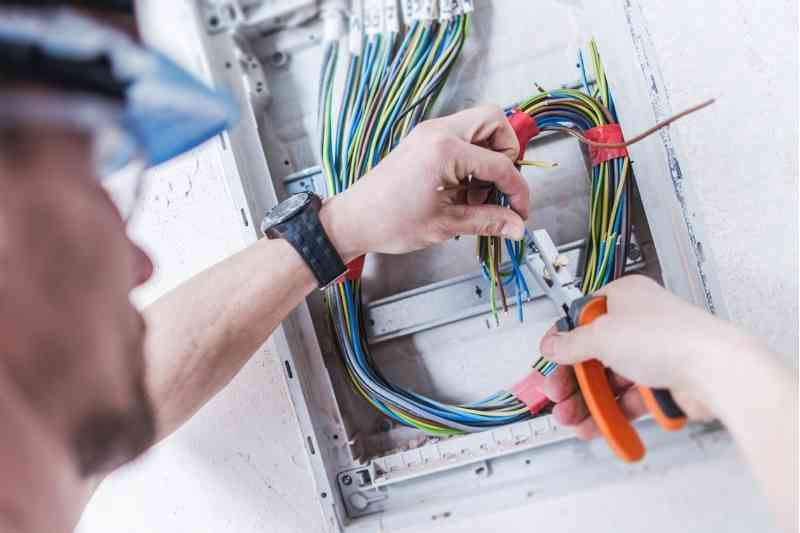Key takeaways
- Low-voltage wiring uses thinner wires to transmit a smaller amount of electricity.
- Structured cabling might be used for common, everyday devices like telephones, WiFi connections, thermostats, and intercoms.
- More specifically, structured cabling should be used for 12V, 24V, or 48V products.
- When you’re installing low-voltage wiring, keep good design, futureproofing, and redundancy in mind.
- It’s worth learning how to install structured cabling if you’re interested in being able to install more devices and expanding your business.

Many of today’s appliances, communication lines, and internet-connected security devices run on low-voltage wiring. It’s a high-demand market — but is it worth learning how to install it? And what should you keep in mind during installation? Don’t worry: this low-voltage wiring guide is here to help.
In this post, we define what low-voltage wiring is and explain which products use it. Then, we review some tips to help you install low-voltage wiring. Finally, we help you decide whether learning how to install it is worth it for your business.
This post covers:
- What is low-voltage wiring?
- What is low-voltage wiring used for?
- What should you keep in mind while installing low-voltage wiring?
- Should you learn how to install structured cabling?
What is low-voltage wiring?
Low-voltage wiring is a type of wiring that is only designed to transmit smaller amounts of volts.
In contrast to high-voltage wiring that supplies larger amounts of electricity, low-voltage wiring has different installation requirements and use cases.
When you consider all of the infrastructure needed to make low-voltage wiring work—like cabling sheaths and insulation—the entire system is called structured cabling.
Structured cabling can be found in every type of property. Structured cabling serves tenants across industries from a multifamily apartment complex to an office building. Low-voltage setups are becoming more popular, especially now that efficiency and sustainability are bigger priorities for your clients.
The buildings you’re working on will have a standard wiring network that usually uses voltage at 120V or 140V. So, to properly and safely install structured cabling, you’ll need to build a separate low-voltage network on top of any existing wiring.
How to identify low-voltage wiring
To identify low-voltage wiring, look for wires that transmit 50 volts of electricity or less. low-voltage products are typically 12V, 24V, or 48V.
You can also check for the thickness, or gauge, of the wire you want to use. You’ll want to use thinner wires in the 12- to 24-gauge range for low-voltage applications.
Types of low-voltage cabling include:
- Fiber optic cables that help computers connect to the internet
- Cat5 and Cat6 cables that handle ethernet connections
- RG-6 cables that handle internet connections in addition to cable and satellite TV
How much voltage can a 12-gauge wire handle?
A 12-gauge wire can handle up to 240 volts. To use these wires safely, be sure to include a circuit breaker that can handle up to 20 amps.
Learn how to install ButterflyMX:
What is low-voltage wiring used for?
Typically, structured cabling is used for hardware related to telecommunications, security, and building automation. These products all need low-voltage to function properly. Otherwise, you risk products failing or even physical danger during installation.
Telecommunication products that use low voltage include:
- Telephones
- Internet and Ethernet connections
- WiFi connections
- Television
Note: Because so many of today’s businesses depend on the internet, structured cabling in commercial buildings is increasingly important.
Building automation products that use low voltage include:
- Garage door openers
- Lighting controls
- Thermostats
- Audiovisual equipment, like speakers
Security products that use low voltage include:
- Intercoms
- Security cameras
- Motion sensors
- Lights
- Alarms

What should you keep in mind while installing structured cabling?
Many products that tenants will use on a daily basis are powered by structured cabling. Here’s what you should keep in mind when installing a structured cabling network.
Three things to consider on a low-voltage wiring job are:
1. Good design
As with any wiring installation, you should make sure that your clients won’t have to deal with the adverse effects of an improperly installed wiring network. Consider variables like airflow and temperature to maximize the lifespan of your structured cabling installation.
2. Futureproofing
Advances in wiring and communications technology happen all the time. For example: This Japanese engineering team recently invented a way for fiber optic cables to also transmit power!
So, you should be sure that it’s easy to replace parts of your wired networks if another, more efficient method of power transmission comes along.
3. Redundancy
By building redundancy into your low-voltage network, you guarantee that your clients will always be able to use the essential products that depend on low-voltage.
Use redundancy in your low-voltage network by making sure that each piece of equipment has more than one way to access a source of electricity. You might also choose to install a backup battery system so that low-voltage products will function even in the case of a power outage.
Should you learn how to install structured cabling?
If you want to attract more clients, you should learn how to install structured cabling. Because the specifics of low-voltage and high-voltage wiring are so different, clients often find that they have to hire two different installers. If you can handle both types of installation, your clients will be grateful — and you’ll be able to charge higher rates.
However, you should remember that becoming a low-voltage electrician involves many hours of learning and earning your certifications.
Low-voltage wiring codes are strict. While these ensure the safety of both installers and clients, it may take a long time to learn to install structured cabling. If you master it, though, that’s one more skill in your portfolio that you can use to get clients and take your business to new heights.






